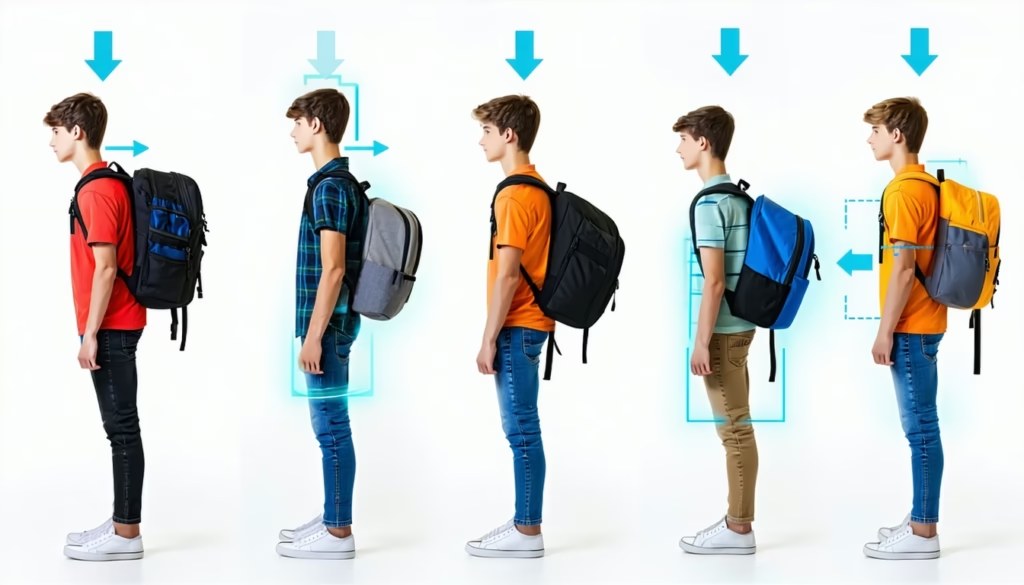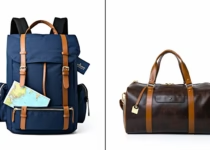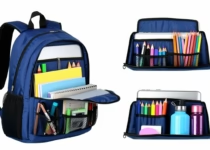Teen Backpacks and Back Posture: Proper Way To Wear

Picture this: You’re rushing out the door, your teen backpack loaded with textbooks, sports gear, and maybe a snack or two. By midday, your shoulders ache and your back feels stiff. Sound familiar? Carrying a heavy bag the wrong way can throw off your back posture and leave you slouching in class.
In this guide, you’ll learn the proper way to wear your teen backpack so you can head to school or practice pain-free. We’ll cover why posture matters, how to choose a backpack that’s right for you, packing tips to balance weight, and daily habits to keep your spine happy.
By the end of this post, you’ll know exactly how to pick, pack, and carry your bag to protect your back, teen backpacks, and back posture, and boost your confidence.
Understanding Back Posture
Your spine isn’t just a stack of bones – it’s a natural S-curve designed to support your body. Good posture keeps that curve in place, distributing weight evenly. When you hunch forward or let a bag sag on one side, you stress muscles and joints.
Health Impacts Of Poor Posture
- Neck and shoulder pain from rounded shoulders
- Muscle fatigue around your upper back
- Lower back strains when weight pulls you backward
- Headaches caused by tension in neck muscles
Long-Term Effects
Poor habits now can lead to chronic pain later. Studies show that teens who carry more than 10 percent of their body weight in a backpack are more likely to experience back discomfort (American Occupational Therapy Association). Over time, misalignment can affect spine growth and lead to posture issues as an adult.
Choosing The Right Backpack
Not all backpacks are created equal. The right features can make a world of difference for your back posture.
Size And Fit Guide
- Look for a bag that sits between your shoulder blades and dips no lower than your waist.
- Choose one with a main compartment that fits your height – about 16 to 18 inches tall for most teen girls.
- Check the backpack’s width against your torso – it should wrap closely without squeezing.
Key Comfort Features
| Feature | Benefit |
|---|---|
| Padded Shoulder Straps | Reduces pressure on shoulders and collarbone |
| Adjustable Sternum Strap | Keeps straps in place and opens your chest |
| Contoured Back Panel | Matches the natural curve of your spine |
| Padded Hip Belt | Offloads weight to your hips (for heavy loads) |
Posture-Friendly Backpack Options
When you shop, look for models designed to support posture. Ergonomic style bags often include breathable mesh panels and built-in frame supports. If you want more info on selecting a bag with just the right back panel, check out this comparison of breathable mesh vs padded back panels for teenage backpacks.
Packing For Balanced Weight
How you pack matters just as much as how you carry. A well-organized bag sits closer to your back and avoids sudden shifts in weight.
Weight Distribution Tips
- Heaviest items go closest to your spine in the middle compartment.
- Lighter items and extras sit in outer pockets.
- Use internal dividers or pouches to avoid items clumping together.
Here’s a quick guide to ideal weight zones:
| Backpack Zone | What To Pack |
|---|---|
| Closest To Back | Textbooks, laptop, binders (heaviest) |
| Middle Section | Notebooks, folders, pencil case |
| Outer Pockets | Water bottle, snacks, small tech gadgets |
| Hip Belt Pouches | Keys, lip balm, transit card |
For more neat-packing ideas, you might like our tips on using color-coding inside a teen backpack for better organization.
Limiting Overall Weight
A good rule is to keep your loaded bag under 10 percent of your body weight. For a 120-pound teen, that’s about 12 pounds. If you’re regularly over that limit, consider swapping paper textbooks for digital versions or using school lockers to stow items between classes.
Adjusting Straps Correctly
Even the best backpack won’t help if your straps are all wrong. Small tweaks can make a big difference.
Step-By-Step Strap Setup
- Loosen all straps before putting the bag on.
- Slip on both shoulder straps evenly.
- Tighten shoulder straps until the bag sits snugly between your shoulder blades.
- Clip and adjust the sternum strap so it rests across your chest (not your neck).
- If available, clip the hip belt around your hips – not your waist – and tighten gently.
Common Strap Mistakes
- Carrying one strap only, which shifts weight unevenly
- Letting the backpack hang below your waist, pulling you backward
- Overtightening so the bag digs into your shoulders
Curious about strap customization? Learn more about customizable strap backpacks for teen girls and how they can add flair while protecting your posture.
Wearing Your Backpack Daily
Wearing your bag right isn’t a one-and-done deal. You’ll need to check your setup regularly.
Classroom Carry Tips
- Stand up straight when moving between classes.
- Shift from one foot to the other occasionally to avoid muscle strain.
- Use lockers when possible to lighten your load midday.
After-School Activities
Switch from school to sports or arts easily by redistributing contents. For example, pack gym clothes in a separate pouch and use a small drawstring bag when you head to practice. If you juggle sports gear and schoolwork in one bag, check out our guide on transitioning backpack use after school sports to study mode.
Preventing Posture Mistakes
Even with the best gear, habits count. Let’s be honest, it’s easy to slip into slouching.
Quick Posture Reminders
- Chin parallel to the floor, shoulders back.
- Pelvis tucked slightly forward to maintain your natural S-curve.
- Knees slightly bent when standing for long periods.
Rushing Without Pain?
Ever sprint to catch the bus and feel that familiar tug? Try a quick posture check before you dash out: tighten your straps, square your shoulders, and engage your core.
Monitoring Your Posture
Regular check-ins help you catch issues early.
At-Home Exercises
- Wall Stand: Lean against a wall with heels, butt, shoulders, and head touching. Hold for 30 seconds.
- Shoulder Rolls: 10 forward, 10 backward to ease tension.
- Core Strength Plank: 20 seconds, build up over time.
On The Move
Set a timer on your phone to remind you every two hours to reset posture. A quick shoulder squeeze and spine alignment take just seconds and help you avoid slouch-induced aches.
Seeking Professional Advice
If you try these tips and still feel persistent pain, it may be time to talk to an adult or healthcare provider.
- School nurse or athletic trainer for quick checks
- Family doctor or physical therapist for ongoing issues
- Orthopedic specialist if pain affects daily life
No question is too small when it comes to protecting your growing spine. Better safe than sorry.
Frequently Asked Questions
-
How heavy should my backpack be?
Aim for under 10 percent of your body weight to avoid strain. -
Can I wear my backpack on one shoulder?
It’s best to use both straps evenly to keep weight balanced. -
How often should I adjust my straps?
Check your strap fit weekly, or anytime you feel a tug or pinch. -
Are wheeled backpacks better for posture?
Wheels reduce strain, but lifting them into lockers still requires care. Balance wheel use with proper lifting technique. -
How do I know if my backpack is too small?
If your books stick out or items bulge unevenly, it’s time to size up. -
Should I use a waist belt every day?
Only if you carry heavy loads (above 10 pounds)—it shifts weight to your hips and reduces shoulder stress. -
Can posture exercises fix habit-related slouching?
Yes, combining strength exercises with mindful carrying habits makes a big difference.
Wrapping Up And Next Steps
Carrying your backpack the right way is a simple habit that pays off in comfort and confidence. Remember to choose a bag that fits, pack thoughtfully, and adjust straps before each wear. Throw in a few posture exercises and check-ins, and your back will thank you.
Now it’s your turn: try one adjustment this week—tighten that sternum strap or lighten your load—and notice how it feels. Got a tip that works for you? Share it in the comments below so everyone can go backpack-happy and pain free.


